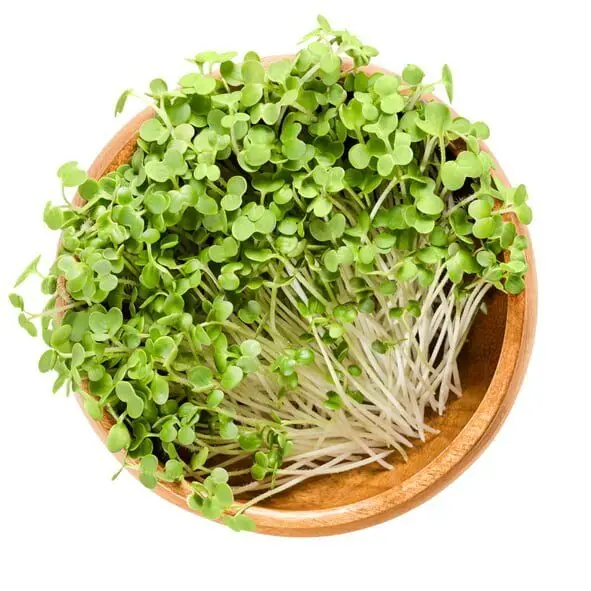Mustard Greens Microgreen Fact Sheet

Mustard greens microgreens, celebrated for their miniature size and remarkable nutritional content, represent a valuable addition to one's dietary repertoire. Delving deeper into their nutrient composition unveils the impressive array of essential components that contribute to their nutritional significance.
Nutrition Profile
Vitamins: Mustard greens microgreens are a concentrated source of essential vitamins.
- Vitamin A: In the form of beta-carotene, these microgreens offer a substantial amount of vitamin A, vital for maintaining healthy vision, immune function, and skin health.
- Vitamin C: Renowned for its antioxidant properties, vitamin C in mustard greens microgreens is pivotal in protecting cellular structures from oxidative damage, bolstering immune defenses, and facilitating collagen production.
- Vitamin K: These microgreens are particularly rich in vitamin K, which plays a pivotal role in blood clotting and bone metabolism, ensuring calcium is appropriately utilized for skeletal health..
Minerals: Mustard greens microgreens are a treasure trove of essential minerals.
- Calcium: Abundant in these microgreens, calcium is crucial for maintaining skeletal integrity, muscular contractions, and nerve function.
- Potassium: A noteworthy source of potassium, these microgreens contribute to the regulation of blood pressure, heart rhythm, and overall cardiovascular health.
- Iron: Mustard greens microgreens provide a substantial supply of iron, indispensable for red blood cell formation, oxygen transport, and energy metabolism.
- Antioxidants: These microgreens are rich in antioxidants, particularly phenolic compounds, which play a vital role in neutralizing harmful free radicals, thereby mitigating the risk of chronic diseases.
Fiber: Mustard greens microgreens offer a significant amount of dietary fiber, which is pivotal for digestive health, maintaining regular bowel movements, and potentially aiding in weight management by promoting a sense of fullness.
Health Benefits
Anti-Inflammatory Properties: Mustard greens microgreens' impressive arsenal of antioxidants and phytonutrients imbue them with potent anti-inflammatory properties. This attribute may help reduce the risk of chronic inflammatory conditions such as cardiovascular diseases and arthritis.
Bone Health: The synergy between ample vitamin K and calcium content in these microgreens supports bone health and may reduce the risk of osteoporosis by ensuring proper calcium utilization.
Immune Enhancement: The combination of vitamins A and C, in addition to other antioxidants, strengthens the immune system, enhancing the body's ability to fend off infections and illnesses.
Cardiovascular Support: Potassium, a vital mineral abundant in mustard greens microgreens, aids in regulating blood pressure, contributing to cardiovascular well-being.
Weight Management: Significant dietary fiber content promotes digestive regularity and may contribute to a sense of fullness, potentially assisting in weight management efforts.
In summary, mustard greens microgreens, though diminutive in size, offer a concentrated source of essential nutrients and bioactive compounds. Their potential health benefits extend from anti-inflammatory and immune-enhancing properties to support for bone health, cardiovascular well-being, and potential assistance in weight management. The inclusion of mustard greens microgreens in one's diet represents a prudent choice for those seeking to optimize their nutritional intake.
References
Beard, J. L. (2001). Iron biology in immune function, muscle metabolism and neuronal functioning. The Journal of Nutrition, 131(2), 568S-580S. https://doi.org/10.1093/jn/131.2.568s
Scalbert, A., Johnson, I. T., & Saltmarsh, M. (2005). Polyphenols: antioxidants and beyond. The American Journal of Clinical Nutrition, 81(1), 215S-217S. https://doi.org/10.1093/ajcn/81.1.215s
Kumar, S., & Pandey, A. K. (2013). Chemistry and biological activities of flavonoids: An overview. TheScientificWorldJournal, 2013, 1–16. https://doi.org/10.1155/2013/162750
Miller, D. D. (1989). Calcium in the diet: Food sources, recommended intakes, and nutritional bioavailability. In Advances in Food and Nutrition Research (Vol. 33, pp. 103–156). Elsevier.
Ross, A. C., Caballero, B., Cousins, R. J., & Tucker, K. L. (2020). Modern nutrition in health and disease (11th ed.). Jones and Bartlett.
Schagen, S. K., Zampeli, V. A., Makrantonaki, E., & Zouboulis, C. C. (2012). Discovering the link between nutrition and skin aging. Dermato-Endocrinology, 4(3), 298–307. https://doi.org/10.4161/derm.22876
Whelton, P. K. (1997). Effects of oral potassium on blood pressure: Meta-analysis of randomized controlled clinical trials. JAMA: The Journal of the American Medical Association, 277(20), 1624. https://doi.org/10.1001/jama.1997.03540440058033
Disclaimer: The information provided in this article is for educational and informational purposes only and is not intended as medical advice. It is not a substitute for professional medical advice, diagnosis, or treatment. Always seek the advice of a qualified healthcare provider with any questions you may have regarding a medical condition. The author and publisher of this article are not responsible for any adverse effects or consequences resulting from the use of any suggestions, preparations, or procedures described in this article.

